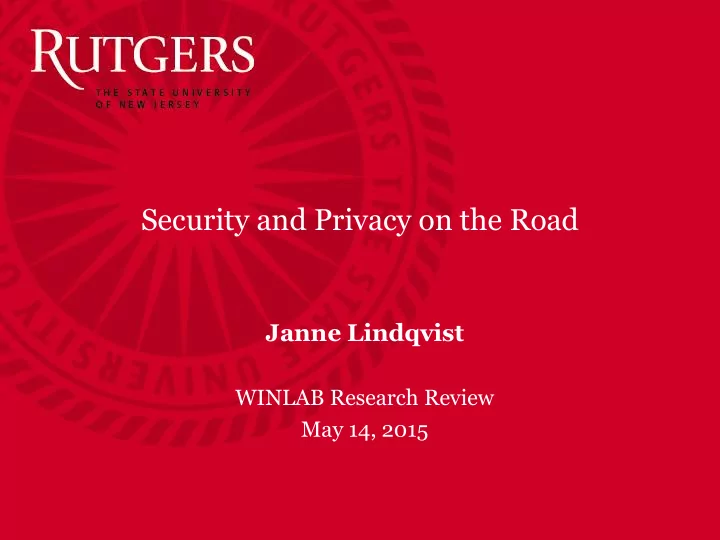

Security and Privacy on the Road Janne Lindqvist WINLAB Research Review May 14, 2015
Very Hard (and Fun!) Problem • Is it possible to track you when we just know your: • Starting location and • Your driving speed with timestamps?
Elastic Pathing: Speed is Enough to Track You Ground Truth Predicted Path 1 Mile 2 km Longitude
Additional Motivation: Usage-Based Automotive Insurance • Some companies claim to only collect speed data to preserve privacy • Examples – PROGRESSIVE: Snapshot device – Allstate: DriveWise device • Starting location: home address known by insurance companies
Key Idea: Elastic Pathing Algorithm • Accumulate distance from speed • Include all the possible paths while matching • Priority First Search: – First explore the candidate path having smallest overall error – Drop the path if current speed is way beyond the speed limit – Sort the possible path according to the overall error – Repeat until complete
Demo
Finding: Accuracy Differs with Drivers
Summary • New Jersey dataset – 14% traces: error less than 250 meters (0.16 miles) – 24% traces: error less than 500 meters (0.31 miles) • Seattle dataset – 13% traces: error less than 250 meters – 26% traces: error less than 500 meters • More information and full demo video at: • http://elasticpathing.org/
Accuracy Differs with Drivers?
• Car theft: a major problem – FBI’s estimate for 2013: “just under 700,000 units” stolen vehicles just in the United States – Only 42.6% of stolen vehicles were recovered in 2008 • Solution : Authenticate drivers by driving behavior – Use driving data – Distinguish between drivers based on their driving habits
DAS: Driving Authentication System DAS ECU Module DAS ECU Module Immobili zer DAS sends the appropriate signal DAS collects to ECU via driving data from Ignition immobilizer. ECU Authorized driver! 95% Enter ID_ Level of confidence Unauthorized driver! 15% Level of confidence DAS decides on User claims authenticity of their identity driver
• System Architecture
• Design Considerations – Number of people • How many people drive the car? – Lending your car • Friend, rental cars etc – Variable driving patterns • Changes in driving behavior at different times – Environmental effect • Changes in weather conditions, road obstruction, etc. – Regional effect • Changes in driving behavior in different cities
• Formal study with 30 participants • Study was conducted in late morning and early afternoon weekdays. • Route A includes only urban areas with high traffic. • Route B includes mostly highway with less or no traffic. • These routes were selected to test various driving maneuvers. • 9.8 miles drive in one driving session, totally driving 19.6 miles. Route A Route B
• Individual Analysis of Drivers Equal Error Rate Driver# Driver# Driver# Driver# Driver# Driver# Driver# Driver# Driver# Driver# 1 2 3 4 5 6 7 8 9 10 EER (%) 0 0 0 6.67 6.67 10 6.67 6.67 0 3.33 Driver# Driver# Driver# Driver# Driver# Driver# Driver# Driver# Driver# Driver# 11 12 13 14 15 16 17 18 19 20 EER (%) 6.67 0 3.33 0 10 13.33 6.67 6.67 13.33 0 Driver# Driver# Driver# Driver# Driver# Driver# Driver# Driver# Driver# Driver# 21 22 23 24 25 26 27 28 29 30 EER (%) 16.67 0 10 0 0 3.33 0 3.33 0 0 • Unfamiliarity with route: inconsistent driving • Road obstruction 15
Summary
Thank you!
Recommend
More recommend